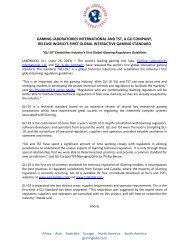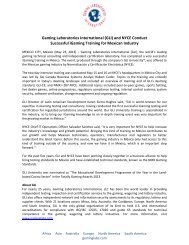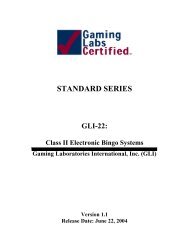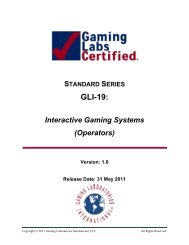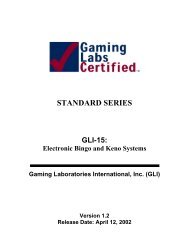GLI-19: - Gaming Laboratories International
GLI-19: - Gaming Laboratories International
GLI-19: - Gaming Laboratories International
You also want an ePaper? Increase the reach of your titles
YUMPU automatically turns print PDFs into web optimized ePapers that Google loves.
<strong>GLI</strong> Standard #<strong>19</strong> – Standards for Interactive <strong>Gaming</strong> Systems (Suppliers) Version 1.0<br />
Final<br />
a) Where sensitive data is being passed over communication lines, such data must be<br />
encrypted. Examples of data that may require encryption are PINs or passwords, account<br />
numbers (including card numbers) and details, encryption keys, player identity details,<br />
funds transfers to and from customer accounts, changes to account details (e.g.: change of<br />
address, change of credit card, change of name, etc.), and game play (i.e.: games played,<br />
amounts bet, amounts won, jackpots won etc.).<br />
b) Data that is not required to be hidden but must be authenticated must use some form of<br />
message authentication technique;<br />
c) Sensitive data must be encrypted on an end-to-end basis (i.e. the data must never appear<br />
on a LAN or WAN in an un-encrypted form). This includes sensitive data transmitted<br />
between computer <strong>Gaming</strong> Platforms within an operator's premises;<br />
d) Sensitive data transmitted between <strong>Gaming</strong> Platforms on a switched network within a<br />
single secure data center need not be encrypted;<br />
e) Sensitive data transmitted between <strong>Gaming</strong> Platforms that are located within separate<br />
secure data centers need not be encrypted if the communications path is physically secure<br />
and cannot be access by unauthorized people;<br />
f) All communications between operator terminals and the <strong>Gaming</strong> Platform must be<br />
strongly authenticated and strongly encrypted during transmission outside their respective<br />
secure data centers; and<br />
g) Authentication must be available via a Secure Socket Link (SSL) and a security<br />
certificate from an approved organization.<br />
h) Encryption algorithms are to be demonstrably secure against cryptanalytic attacks;<br />
i) Operators must have approved procedures for following up reports of weaknesses in<br />
encryption algorithms used in any part of the <strong>Gaming</strong> Platform (including, but not limited<br />
to, RNGs, firewalls, authentication systems and operating <strong>Gaming</strong> Platform). Changes to<br />
encryption algorithms to correct weaknesses must be implemented as soon as practical. If<br />
no such changes are available, the algorithm must be replaced.<br />
7.3.8 Cryptographic Key Management.<br />
a) The minimum width (size) for encryption keys is 112 bits for symmetric algorithms and<br />
1024 bits for public keys.<br />
Chapter Seven: Information Systems Security (ISS) Requirements Page 57<br />
Copyright © 2011 <strong>Gaming</strong> <strong>Laboratories</strong> <strong>International</strong>, LLC<br />
All Rights Reserved.




